The Significance of Adequate Ventilation in Your Home's Plumbing Systems
The Significance of Adequate Ventilation in Your Home's Plumbing Systems
Blog Article
Do you find yourself interested in facts about What Are Plumbing Vents and Why Are They Important??

Correct air flow in plumbing systems is typically neglected, yet it is crucial for preserving the functionality and safety and security of your home's plumbing. Air flow assists regulate atmospheric pressure, avoid the accumulation of unsafe gases, and ensure the efficient elimination of waste. In this overview, we will discover the relevance of appropriate plumbing ventilation, just how it functions, and the benefits it gives your plumbing system.
How Ventilation Works in Pipes Solutions
Air Pressure Regulation
Proper ventilation keeps well balanced air pressure within the plumbing system. When water streams with pipelines, it displaces air. Without adequate air flow, this displacement can create unfavorable stress, leading to reduce drains pipes or siphoning of water from traps, which can cause unpleasant odors to leak right into the home.
Preventing Sewer Gas Buildup
Among the most crucial features of pipes vents is to prevent sewer gases, such as methane and hydrogen sulfide, from accumulating within the home. These gases can posture major wellness threats and are very combustible. Vent pipelines enable these gases to leave safely outdoors.
Helping in Waste Removal
Ventilation aids in the effective removal of wastewater by avoiding airlocks in the water drainage system. When air can stream freely via the vents, it enables water and waste to flow efficiently through the pipes, minimizing the risk of blockages and back-ups.
Benefits of Appropriate Ventilation
Boosted System Effectiveness
Appropriately ventilated plumbing systems operate a lot more effectively, with fewer clogs, faster draining, and less stress on the pipelines. This effectiveness prolongs the lifespan of the plumbing system.
Improved Air Top Quality
By avoiding sewer gases from entering your home, appropriate air flow contributes to far better indoor air top quality, making your living environment healthier and more comfortable.
Avoiding Water Damage
Sufficient ventilation helps avoid water from being siphoned out of traps, which can result in sewer gases getting in the home and creating water damages gradually.
Steps to Guarantee Proper Air Flow
Consulting Plumbing Codes
Always consult local plumbing codes when developing or changing your pipes system. These codes offer the essential standards for appropriate airing vent and guarantee your system satisfies security requirements.
Routine Assessment and Upkeep
Normal inspections can aid identify potential air flow issues prior to they become significant troubles. Maintenance tasks, such as cleaning up air vent pipelines and looking for blockages, are necessary for maintaining the system in good working order.
Specialist Installation
For new setups or major adjustments, it's smart to employ an expert plumber. They have the knowledge to make sure the ventilation system is correctly designed and mounted according to code.
Recognizing Air Flow in Plumbing
Ventilation in pipes refers to the network of pipelines that enable air to flow through the water drainage system. These vents offer several purposes, consisting of managing air pressure within the pipelines, preventing sewer gases from getting in the home, and assisting in the smooth circulation of wastewater.
Kinds Of Pipes Vents
Main Stack Vent
The primary pile vent, likewise referred to as the air vent stack, is the primary vent in a pipes system. It extends from the primary drainpipe line up via the roofing, enabling gases to run away and fresh air to get in the system.
Branch Vent
Branch vents link to the primary stack vent and offer specific components, such as sinks, bathrooms, and showers. These vents guarantee that each fixture has ample air flow to function properly.
Air Admittance Valve (AAV).
An Air Admission Valve (AAV) is a one-way valve that enables air to get in the pipes system without the need for a standard vent pipe extending with the roof. AAVs are typically used in restorations or locations where mounting a common air vent is unwise.
Indicators of Poor Ventilation in Pipes.
Slow Draining Fixtures.
If your sinks, bathtubs, or toilets are draining pipes gradually, maybe a sign of bad air flow. Poor air flow can produce a vacuum cleaner result, making it hard for water to drain appropriately.
Gurgling Seems.
Gurgling audios originating from drains pipes are usually an outcome of air being drawn via water catches due to negative stress in the pipelines. This is a clear indication of insufficient air flow.
Undesirable Smells.
Drain odors inside your home are a warning that your plumbing system is not appropriately aerated. This could mean that sewer gases are not being sufficiently vented outside, bring about potentially hazardous conditions.
Common Ventilation Blunders.
Inadequate Vent Sizing.
Making use of undersized vent pipelines can cause bad air flow and stress imbalances in the system. It's necessary to make use of vents that satisfy the specific needs of your pipes system.
Improper Vent Positioning.
Putting vents too much from the fixtures they offer can reduce their performance. Proper positioning guarantees that air can move freely and effectively via the system.
Ignoring Code Demands.
Building codes supply details guidelines for plumbing air flow. Overlooking these codes can result in a system that fails to work correctly and might lead to costly repairs or carcinogen.
Conclusion.
Proper ventilation is an essential element of any kind of plumbing system, making certain that it works effectively and safely. By understanding the importance of ventilation, recognizing the signs of bad air flow, and taking actions to keep your system, you can prevent costly issues and shield your home's air high quality.
4 Things You Should Know About Your Plumbing Vents
What Plumbing Vents Are
Also called a vent stack, a plumbing vent is a vertical pipe attached to your drain line that runs through your roof. The plumbing vent pipe, or plumbing air vent, removes gas and odors from your plumbing system and allows fresh air to enter the pipes, helping the water to flow out of the drain pipes.
What Plumbing Vents Do
Plumbing vents have two basic functions. One of which is to allow unpleasant smelling wastewater and sewer gasses to escape your plumbing system instead of entering your home. Plumbing vent pipes are typically located on roofs, away from windows, to ensure the fumes exit the home completely.
The other function of the plumbing vent is to move fresh air into your plumbing system. This helps move water through every plumbing fixture in your house, like toilets and sink drains. Think of the way in which you need to let a little air into the bottle as you pour soda in order to make the drink flow smoothly.
Different Types of Plumbing Vents
True vent: This is the most common vent option. In simplest terms, a true vent is a vertical pipe attached to your drain line that exits through the roof. They often function as the main vent that other fixtures can connect to. Re-vent pipe or auxiliary vent: Attached to the drain line near specific plumbing fixtures, re-vent pipes run up and over to connect to the main vent. Common vent: Two plumbing fixtures installed on opposite sides of a wall are typically tied into the vent stack using something known as a sanitary cross. Wet vent: This venting option operates as a drain pipe and a vent at the same time. Wet vent drainage systems drain water from one fixture while venting the air from another. Although they’ve been used for over 100 years, wet vent systems have only recently been added to the plumbing code in many areas. If you’re planning on installing one in a bathroom remodel, make sure you check your local code prior to construction. Loop vent: For free-standing fixtures like kitchen island sinks, loop vents are ideal. These vent pipes run under the floor, rise from the P-trap, and create a loop inside the cabinet sink. Air admittance valve: An AAV is a one-way mechanical valve typically installed at the site of the plumbing fixture. AAVs allow venting to occur without having to tie into a larger venting system. They’re ideal for venting fixtures where you aren’t able to easily connect to an existing vent system. Common Plumbing Vent Issues
Although vent pipes typically don’t have water flowing through them, they’re still subject to many typical plumbing issues. For example, clogs are one of the most common problems associated with sewer vent pipes. If your vent pipe gets clogged, all of your plumbing fixtures tied into the vent stack will be affected.
A sink with a slow drain that bubbles and gurgles or a strong sewage smell around your toilet are both indicators that your toilet vent pipe is clogged. Because most vent pipes exit through the roof, old leaves, twigs or even a bird’s nest could be clogging the pipe.
Clogs in your vent pipe system cause a buildup of negative pressure, meaning that water won’t be able to flow out of your home very well. It’s similar to putting your finger over the opening of a straw to trap water inside. When you remove your finger, the water is able to flow out of the straw.
If you suspect you have any blockage in your vent, make sure you have a professional come examine the situation. Left unchecked, a blocked air vent can lead to other costly repairs, like leaks and sediment buildup.
Under Pressure
Pipe vents are essential aspects of a home’s plumbing system. Owning a home means learning about all sorts of things you never put much thought into before. But by understanding as much as you can about the important systems of your home, you can keep those budgets intact and those anxiety levels low.
https://www.homeserve.com/en-us/blog/home-improvement/plumbing-vents/

Do you appreciate reading about The Upsides of Proper Ventilation in Plumbing Design? Create a remark further down. We'd be happy to see your feelings about this blog post. We hope that you visit us again in the near future. Are you aware of another individual who is in to the topic? Please feel free to promote it. I am grateful for being here. Come back soon.
Schedule Your Job Now Report this page